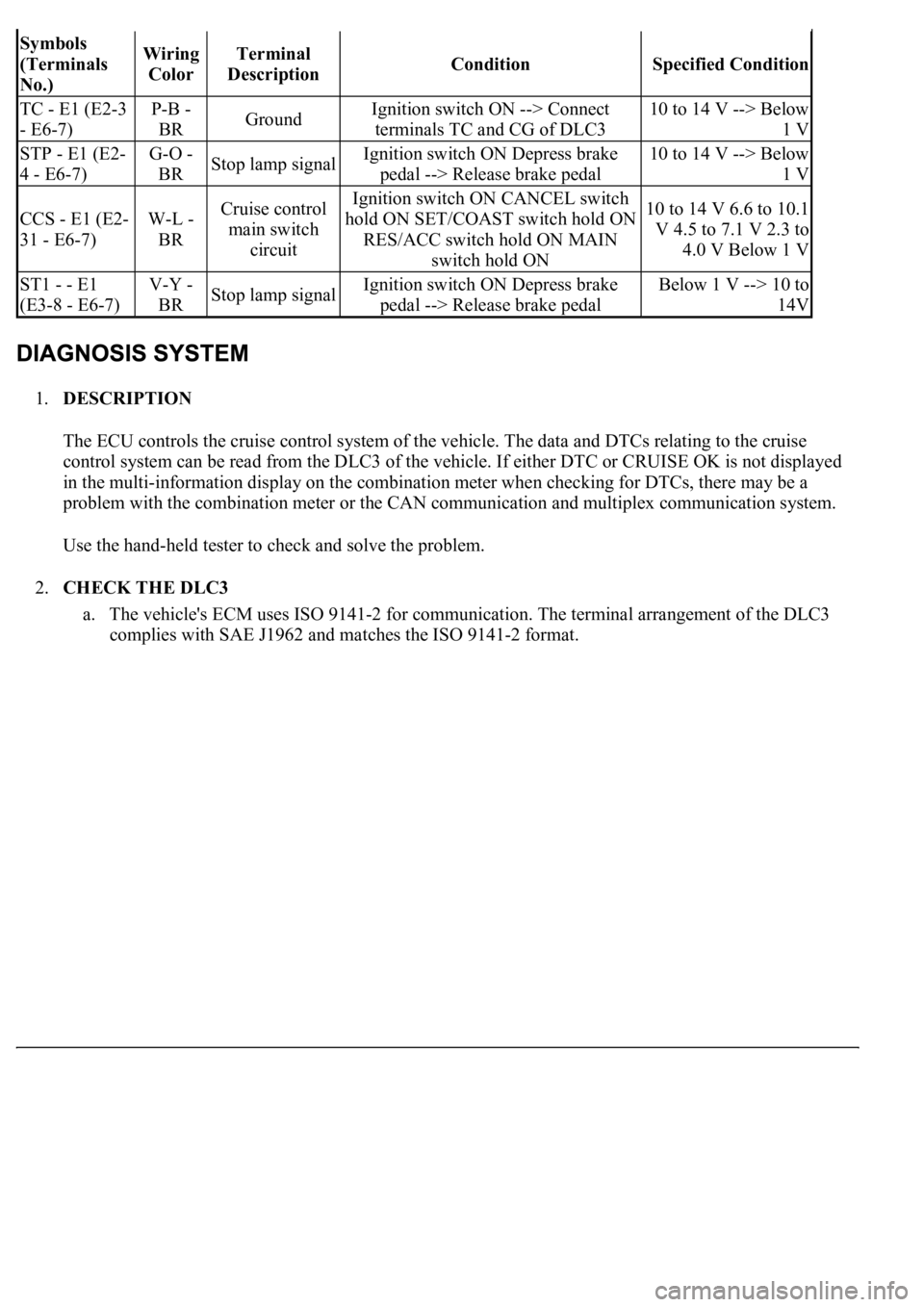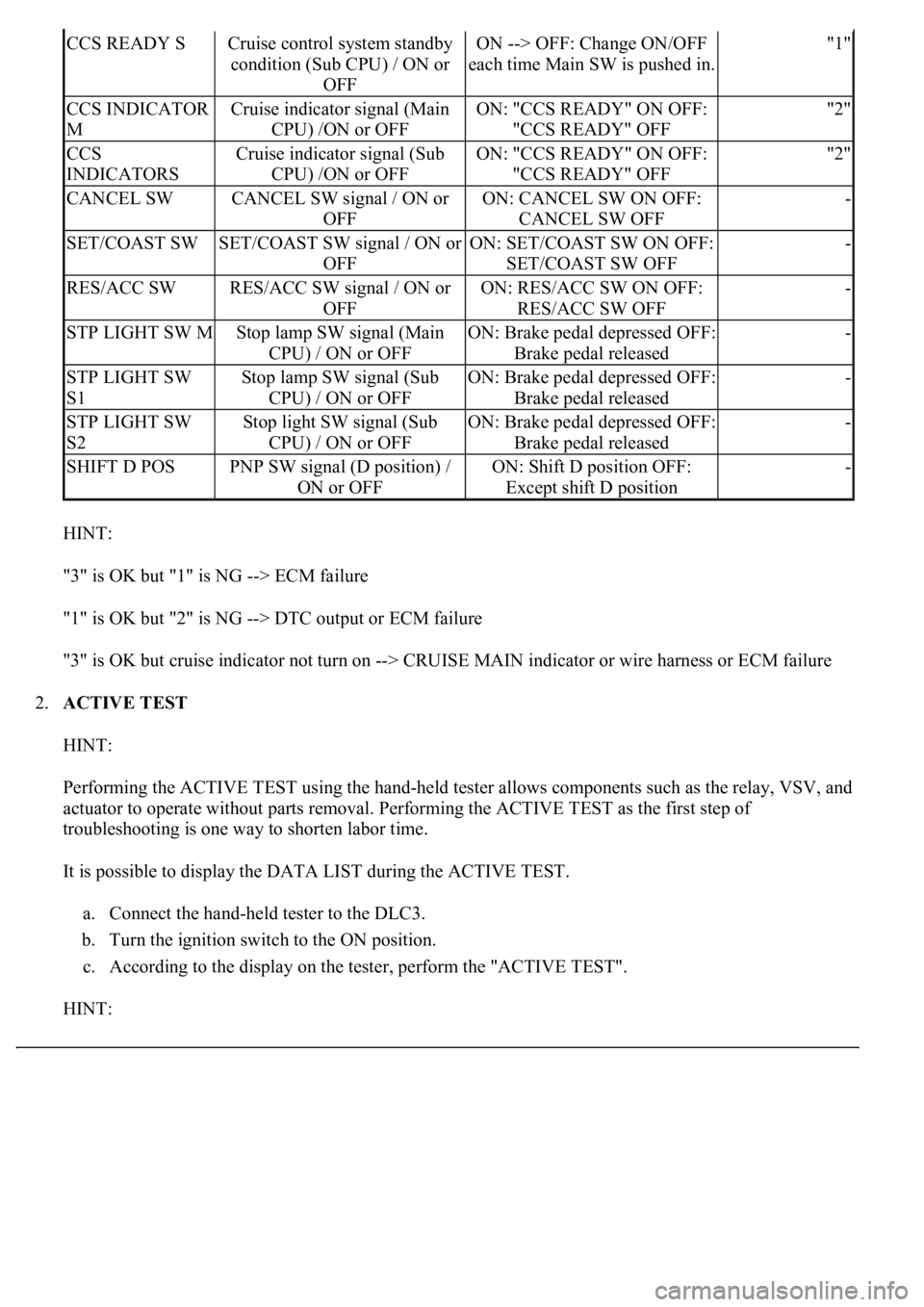Page 1907 of 4500
TROUBLE CODE (GO TO STEP 8)
NORMAL SYSTEM CODE (GO TO STEP 9)
8.(SEE DIAGNOSTIC TROUBLE CODE CHART
)
GO TO STEP 12
9.PROBLEM SYMPTOM SIMULATION
SYMPTOM DOES NOT OCCUR (GO TO STEP 10)
SYMPTOM OCCURS (GO TO STEP 11)
10.SYMPTOM SIMULATION (SEE ELECTRONIC CIRCUIT INSPECTION PROCEDURE
)
11.(SEE PROBLEM SYMPTOMS TABLE
)
12.CIRCUIT INSPECTION (SEE DTC P0500 VEHICLE SPEED SENSOR CIRCUIT
MALFUNCTION, DTC P0503 VEHICLE SPEED SENSOR CIRCUIT MALFUNCTION -
DIAGNOSIS CIRCUIT
)
13.(SEE TERMINALS OF ECM
)
14.IDENTIFICATION OF PROBLEM
15.REPAIR OR REPLACE
16.CONFIRMATION TEST
END
Page 1914 of 4500
Fig. 10: Problem Symptoms Chart
Courtesy of TOYOTA MOTOR SALES, U.S.A., INC.
Fig. 11: Identifying ECM Terminals
Courtesy of TOYOTA MOTOR SALES, U.S.A., INC.
ECM TERMINALS VOLTAGE SPECIFICATION
Page 1915 of 4500

1.DESCRIPTION
The ECU controls the cruise control system of the vehicle. The data and DTCs relating to the cruise
<004600520051005700550052004f00030056005c00560057004800500003004600440051000300450048000300550048004400470003004900550052005000030057004b004800030027002f0026001600030052004900030057004b004800030059004800
4b004c0046004f004800110003002c004900030048004c0057[her DTC or CRUISE OK is not displayed
in the multi-information display on the combination meter when checking for DTCs, there may be a
problem with the combination meter or the CAN communication and multiplex communication system.
Use the hand-held tester to check and solve the problem.
2.CHECK THE DLC3
a. The vehicle's ECM uses ISO 9141-2 for communication. The terminal arrangement of the DLC3
complies with SAE J1962 and matches the ISO 9141-2 format.
Symbols
(Terminals
No.)Wiring
ColorTerminal
DescriptionConditionSpecified Condition
TC - E1 (E2-3
- E6-7)P-B -
BRGroundIgnition switch ON --> Connect
terminals TC and CG of DLC310 to 14 V --> Below
1 V
STP - E1 (E2-
4 - E6-7)G-O -
BRStop lamp signalIgnition switch ON Depress brake
pedal --> Release brake pedal10 to 14 V --> Below
1 V
CCS - E1 (E2-
31 - E6-7)W-L -
BRCruise control
main switch
circuitIgnition switch ON CANCEL switch
hold ON SET/COAST switch hold ON
RES/ACC switch hold ON MAIN
switch hold ON10 to 14 V 6.6 to 10.1
V 4.5 to 7.1 V 2.3 to
4.0 V Below 1 V
ST1 - - E1
(E3-8 - E6-7)V-Y -
BRStop lamp signalIgnition switch ON Depress brake
pedal --> Release brake pedalBelow 1 V --> 10 to
14V
Page 1918 of 4500
If a malfunction occurs in the vehicle speed sensors, stop lamp switch assy, or other related parts during
cruise control driving, the ECM actuates AUTO CANCEL of the cruise control and then the CRUISE
main indicator light starts to blink, informing the driver of the malfunction. At the same time, data of the
malfunction is stored as a diagnostic trouble code (DTC).
Fig. 14: Identifying Blinking Pattern Of CRUISE Main Indicator Light
Courtesy of TOYOTA MOTOR SALES, U.S.A., INC.
1.DTC CHECK
a. Connect the hand-held tester to the DLC3.
b. Turn the ignition switch to the ON position.
c. Read the DTCs on the tester screen.
2.DTC CLEAR
Page 1919 of 4500
Fig. 15: Connecting Hand-Held Tester To DLC3
Courtesy of TOYOTA MOTOR SALES, U.S.A., INC.
a. Connect the hand-held tester to the DLC3.
b. Turn the ignition switch to the ON position.
c. Clear the DTCs following the prompts on the tester screen.
1.If the following conditions are detected while the cruise control is in operation, the system clears the
stored vehicle speed in the ECM and cancels the cruise control operation.
Page 1920 of 4500

Fig. 16: Fail-Safe Chart
Courtesy of TOYOTA MOTOR SALES, U.S.A., INC.
1.DATA LIST
a. While the hand-held tester is connected to the DLC3 and with the ignition switch turned to the ON
position, the CRUISE CONTROL data list can be displayed. Follow the prompts on the tester
screen to access the data list.
DATA LIST (CC (ECM))
Item
Measurement Item / Display
(Range)
Normal ConditionDiagnostic Note
VEHICLE SPDVehicle speed / min.: 0 km/h (0
mph), max.: 255 km/h (158
mph)Actual vehicle speed-
MEMORY SPDCruise control memorized
speed / min.: 0 km/h (0 mph),
max.: 255 km/h (158 mph)Actual stored vehicle speed-
THROTTLERequired throttle opening angle /
min.: 0°, max.: 125°Actual required throttle opening-
CRUISE CTRLCruise control system active
condition / ON or OFFON: Cruise control activated
OFF: Cruise control inactivated-
MAIN SW
(MAIN)Main SW signal (Main CPU) /
ON or OFFON: Main SW ON (Pushed on)
OFF: Main SW OFF (Pushed
off)"3"
MAIN SW (SUB)Main SW signal (Sub CPU) /
ON or OFFON: Main SW ON (Pushed on)
OFF: Main SW OFF (Pushed
off)"3"
CCS READY MCruise control system standby
condition (Main CPU) / ON or
OFFON --> OFF: Change ON/OFF
each time Main SW is pushed in."1"
Page 1921 of 4500

HINT:
"3" is OK but "1" is NG --> ECM failure
"1" is OK but "2" is NG --> DTC output or ECM failure
"3" is OK but cruise indicator not turn on --> CRUISE MAIN indicator or wire harness or ECM failure
2.ACTIVE TEST
HINT:
Performing the ACTIVE TEST using the hand-held tester allows components such as the relay, VSV, and
actuator to operate without parts removal. Performing the ACTIVE TEST as the first step of
troubleshooting is one way to shorten labor time.
It is possible to display the DATA LIST during the ACTIVE TEST.
a. Connect the hand-held tester to the DLC3.
b. Turn the ignition switch to the ON position.
c. According to the display on the tester, perform the "ACTIVE TEST".
HINT:
CCS READY SCruise control system standby
condition (Sub CPU) / ON or
OFFON --> OFF: Change ON/OFF
each time Main SW is pushed in."1"
CCS INDICATOR
MCruise indicator signal (Main
CPU) /ON or OFFON: "CCS READY" ON OFF:
"CCS READY" OFF"2"
CCS
INDICATORSCruise indicator signal (Sub
CPU) /ON or OFFON: "CCS READY" ON OFF:
"CCS READY" OFF"2"
CANCEL SWCANCEL SW signal / ON or
OFFON: CANCEL SW ON OFF:
CANCEL SW OFF-
SET/COAST SWSET/COAST SW signal / ON or
OFFON: SET/COAST SW ON OFF:
SET/COAST SW OFF-
RES/ACC SWRES/ACC SW signal / ON or
OFFON: RES/ACC SW ON OFF:
RES/ACC SW OFF-
STP LIGHT SW MStop lamp SW signal (Main
CPU) / ON or OFFON: Brake pedal depressed OFF:
Brake pedal released-
STP LIGHT SW
S1Stop lamp SW signal (Sub
CPU) / ON or OFFON: Brake pedal depressed OFF:
Brake pedal released-
STP LIGHT SW
S2Stop light SW signal (Sub
CPU) / ON or OFFON: Brake pedal depressed OFF:
Brake pedal released-
SHIFT D POSPNP SW signal (D position) /
ON or OFFON: Shift D position OFF:
Except shift D position-
Page 1923 of 4500
Fig. 18: DTC P0500 And P0503 Problem Symptom Diagnostic Chart
Courtesy of TOYOTA MOTOR SALES, U.S.A., INC.
WIRING DIAGRAM
See WIRING DIAGRAM
INSPECTION PROCEDURE
See INSPECTION PROCEDURE
.
CIRCUIT DESCRIPTION
When the brake pedal is depressed, the stop lamp switch assy sends a signal to the ECM. When the ECM
receives this signal, it cancels the cruise control.
Fail-safe function operates to enable normal driving even if there is a malfunction in the stop lamp signal
circuit.
The cancel condition occurs when positive battery voltage is applied to terminal STP.
When the brake is applied, battery positive voltage is normally applied to terminal STP of the ECM through the
STOP fuse and the stop lamp switch assy, and the ECM turns the cruise control off.
Fig. 19: DTC P0571 Problem Symptom Diagnostic Chart
Courtesy of TOYOTA MOTOR SALES, U.S.A., INC.
WIRING DIAGRAM